Review of Chinese UMPC Gome FlyTouch
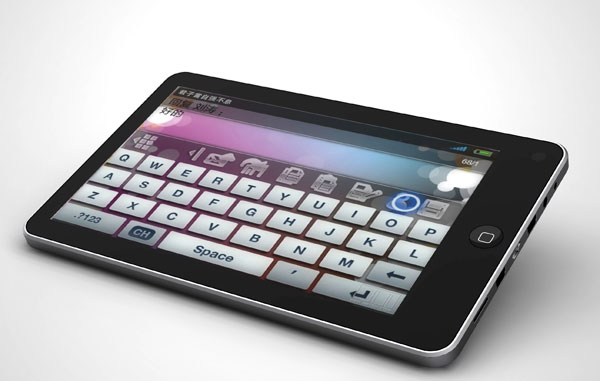
With the advent of Google Android OS, the market for Chinese tablet PCs began to grow rapidly and currently represents a huge collection of a wide variety of devices, attractive for their cheapness and good (at least declared) technical characteristics.
One such device in the price range “up to $ 200” is the UMPC “FlyTouch” from Gome.
An overview of this miracle of the Chinese industry I will conduct under the cut ( carefully, traffic! ).
To begin with, the Chinese market is very specific in terms of naming devices and their external differences.
Simply put - 90% of “ultra mobile PCs” look about the same and most often get a name by randomly mixing words from aPad, ePad, ePed, iRobot, Touch Android Camera Tablet PC, and so on.
Therefore, it is worth paying attention not to the name of the device and not to the design of its case, but to the characteristics declared regarding its hardware.
My Gome FlyTouch sample has the following characteristics:
OS: Google Android 1.6
CPU: VIA WM8505, ARM9 platform
Memory: 256 Mb DDR-2
Storage: 1Gb internal memory + microSD expansion slot with support for cards up to 32Gb
Networks: 10/100 Mb Fast Ethernet (via adapter) + Wi-Fi 802.11 b / g WLan (built-in)
Camera: 0.3 Mp, 640x480, встроенная
Audio: встроенный микрофон, встроенные стерео-динамики, выход на наушники
Display: 7" LCD, 800x480, резистивный (тачскрин, но никакого мультитача) углы обзора примерно 45-50 градусов.
Также устройство имеет встроенный кардридер microSD/TF карт, 2 USB 2.0 OTG порта (через адаптер), и литий-полимерный аккумулятор на 2400 mAh.
Устройство приехало ко мне в посылке, щедро замотанной в упаковочный полиэтилен.
Освобождаем посылку от упаковочного материала и обнаруживаем «фирменную» коробку:
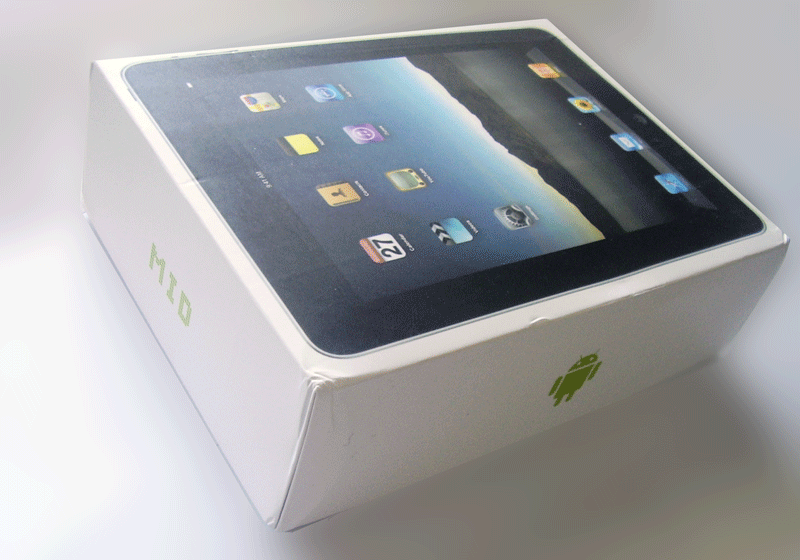
Плотный белый картон, полиграфия на уровне струйного принтера, ничего особенного. Открываем, разбираем.

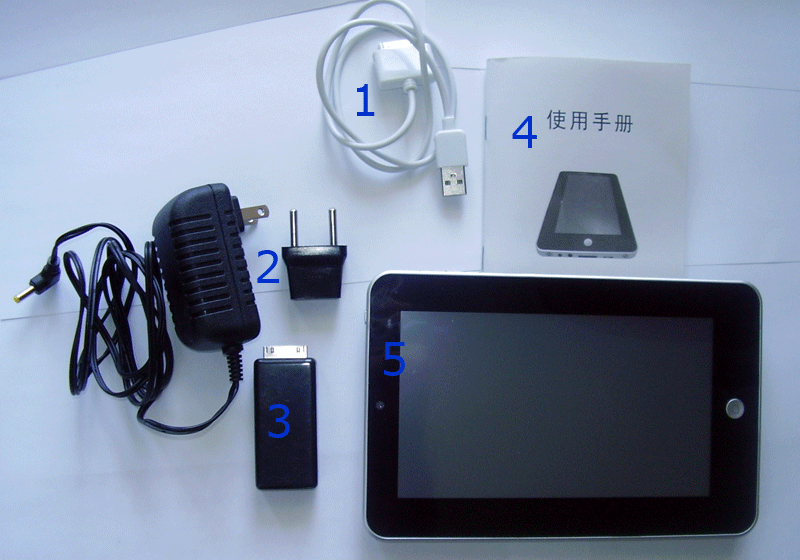
Внутри коробки нас ждет:
1) Cord for connecting to a PC disguised as a Mac;
2) Charger with adapter for European outlets;
3) A special adapter that allows you to connect 2 USB devices and an RJ45 connector;
4) Instruction in native (but not for me) Chinese;
5) Actually, FlyTouch itself;
If you turn the device in your hands, in addition to the large round button on the front side, we find the power button on the left side, the volume rocker and the menu button on the top of the device:
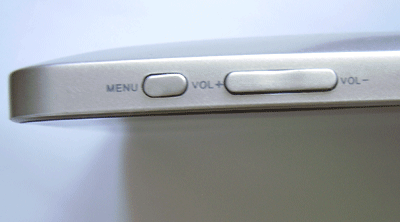
And a number of connectors on the right side:
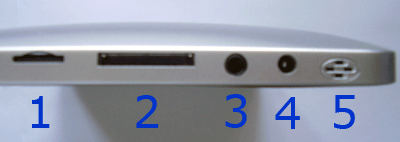
1) A slot for microSD / TF cards;
2) A connector for connecting a synchronization cord or a USB-RJ45 adapter;
3) Headphone output;
4) Connector for connecting the charger;
5) One of the speakers (the second did not get into the frame and is located to the left of the microSD card slot);
The back of the device is completely monolithic, gray and dull:
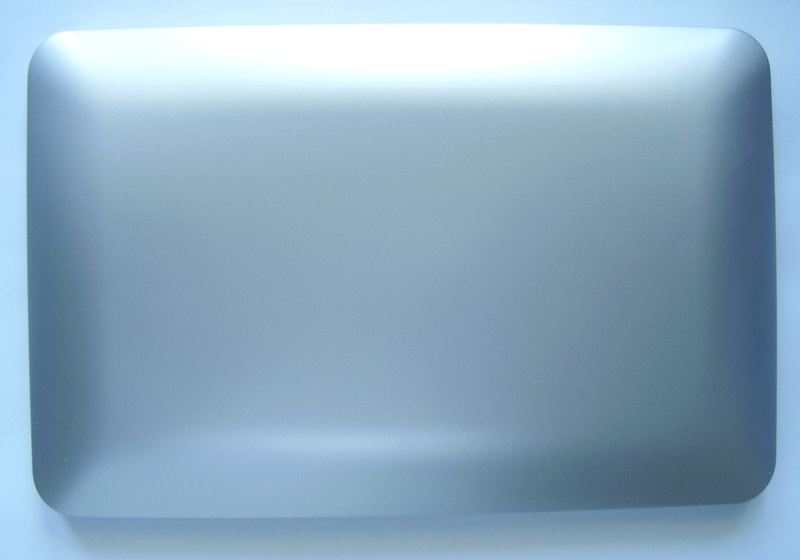
Our UMPC is lightweight by weight (370 grams), dimensions: 20 by 13 by 1.2 cm.
The plastic is quite pleasant to the touch, slightly rough, the front panel and the screen are glossy.
The device is assembled neatly enough, but not perfectly - when spinning in the hands, the plastic creaks slightly, apparently there are backlashes between the components of the case.
We turn on the device by pressing the "power" button on the left edge.
The OS loads quickly enough (up to 30 seconds from the moment the button was pressed), but for the sake of fairness, I’ll note that on the very first day I flashed the device to the “assembled” firmware from Slatedroid, which I have never regretted because it works much faster and more stable native, so all screenshots and photos are valid for this firmware.

The device is on. Next - Nokia E51 for visual comparison of dimensions.
The screen has good brightness and contrast.
The desktop widget has three brightness presets (you can add your own), the maximum brightness is enough for working outdoors, the average is enough to work comfortably indoors, and the minimum brightness is great for reading in the dark.

The interface is “finger-oriented”, at first it was unusual to “flip” and “poke” with your fingers instead of the stylus, but I must admit that it’s convenient enough until it comes to typing (there are no advantages over the stylus).
Through the USB adapter,

you can connect a keyboard and mouse (then a small arrow will appear on the screen), after which the device turns into a practically netbook.
The keyboard works fully, the mouse - the left button symbolizes pressing, the right - calls up the application’s context menu, scroll - scrolls the window up or down.
You can connect USB flash drives to USB ports (I’ve got all the 5 pieces found in the house from different manufacturers, different capacities and year of release that worked perfectly, I note that NTFS is not supported by Android), the write / read speed is high, like on a regular PC.
Also, all the mice, keyboards, and external hard drives that I found worked in USB ports (I tried WD, Samsung and Transcend), but I could not get 3G modem and a webcam working.
As for the built-in camera, there is one, and you should not talk about it anymore, because the picture quality is terrible, and this camera cannot be used in instant messengers (Skype, QQ, etc.) for video calls, so the use of this camera aims to to zero.
The built-in microphone, on the contrary, has good sensitivity, is “friends” with Skype and normally copes with its duties.
Connecting to the network via the RJ45 connector works without complaints, but basically I used Wi-Fi, the quality of which also does not cause complaints.
The built-in browser (Chrome Lite) loads pages perfectly, no slower than any browser on my PC.
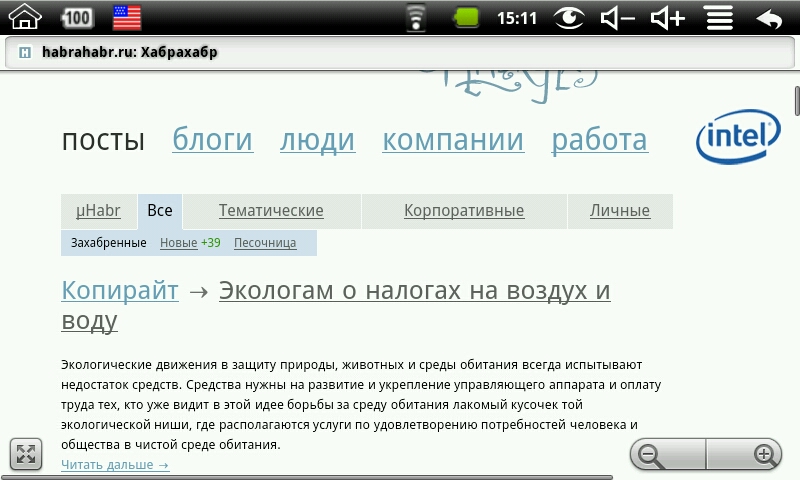
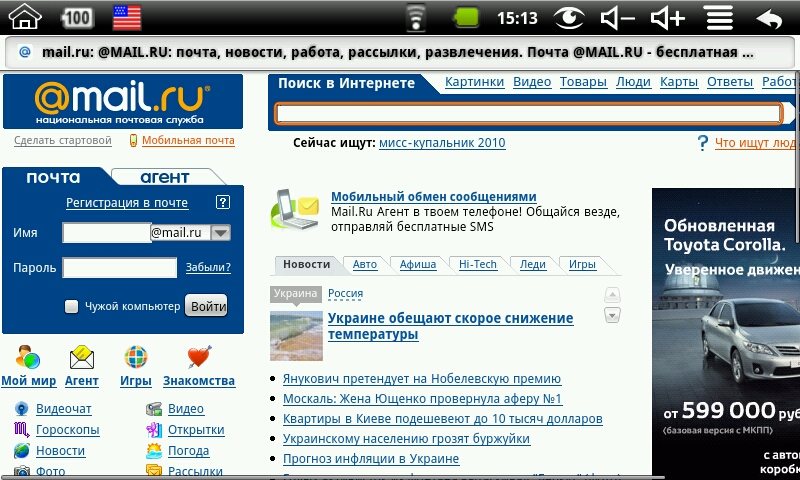
Almost everything (Java scripts, Ajax) works in the browser, except for the flash (its operation is not possible in Android OS below 2.0), and SilverLight.
There is a separate application for YouTube, you can watch videos.
If you confine yourself to typing, reading books (FBReader works simply divinely, after small screens on your phone and PDA, reading books with a resolution of 800x480 is just a pleasure), mail, chat rooms, working with documents, office, pictures, music and the Internet - then the device does everything without brakes and stumbles. Small toys like sudoku or chess also work quite nicely.
But for watching videos (anyone except YouTube), and full-screen games, the device is completely unsuitable. The reason for this is a weak processor without a DSP. If you need to watch a video, you should pay attention to devices with a more expensive RockChip 2808 processor
. VIA W8505 is installed in our device, apparently, it clocked up to 533 megahertz.
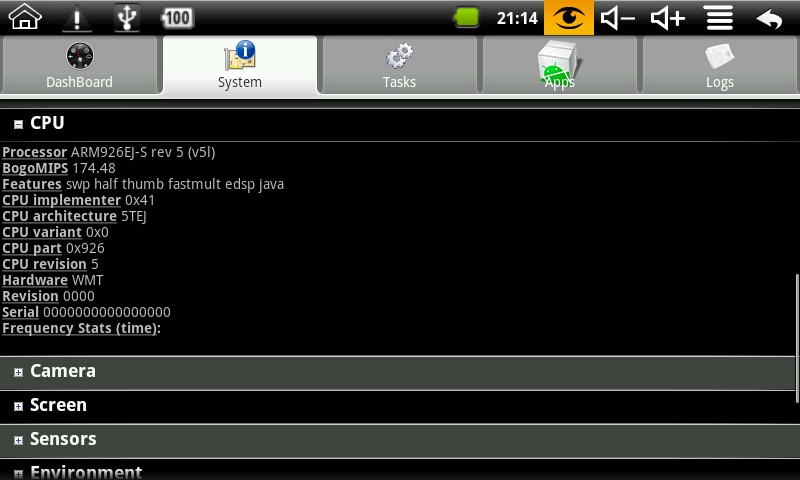

The firmware of the device (both original and from SlateDroid) has a good Russian localization, although not complete. Russian (Ukrainian) layouts are installed additionally by the corresponding program.

The buttons are large, pressing is convenient. When pressed, a pleasant “glass” sound sounds :)
Reading books, as already mentioned, is very convenient. The volume rocker in this case works like a leaf list of pages.
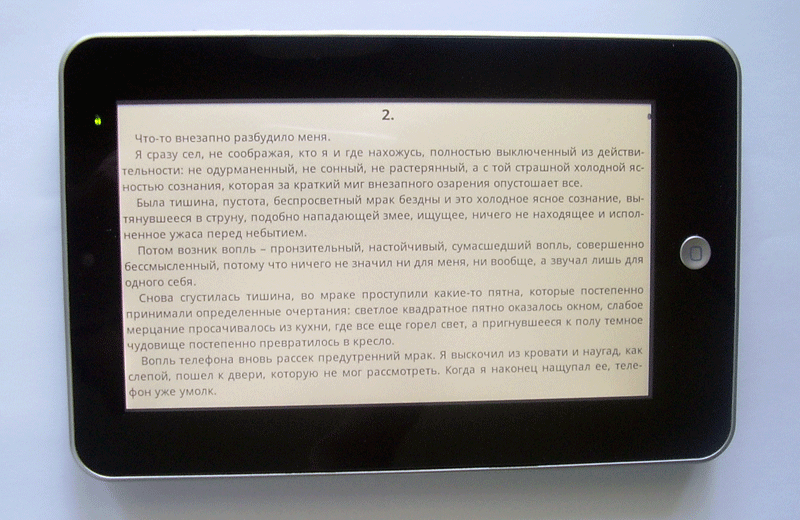
Built-in software - Google Mail, Google Talk - nice, convenient, ready to work out of the box.

For lovers of social networks, there was an application "Vkontakte" that allows
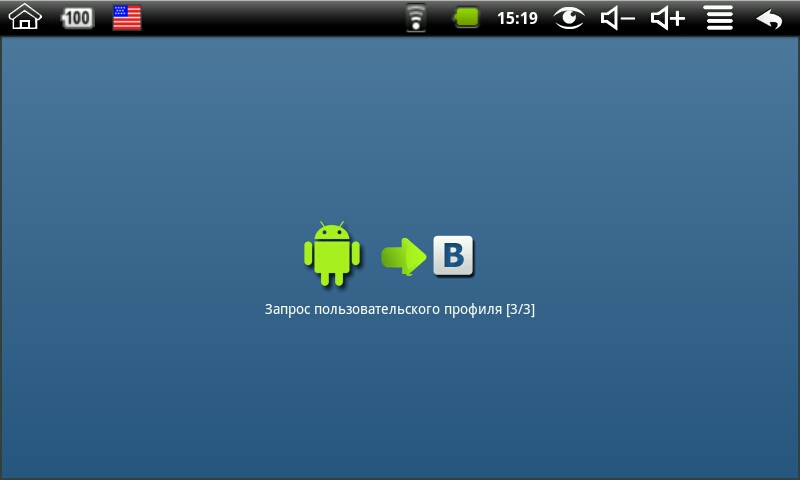
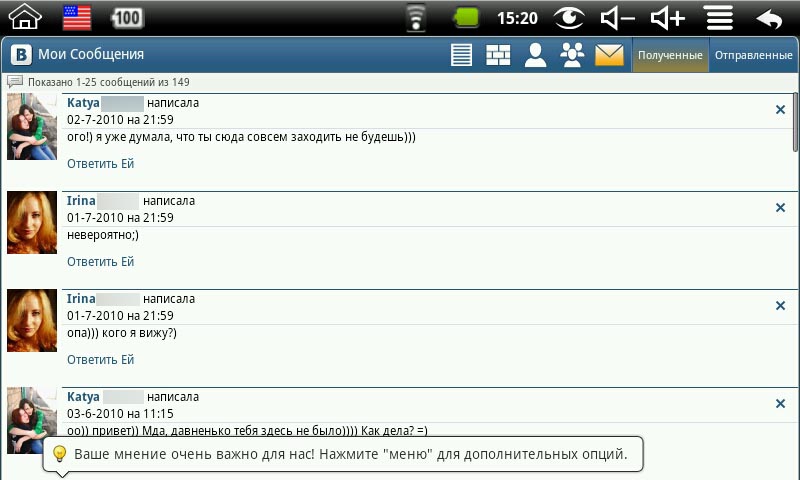
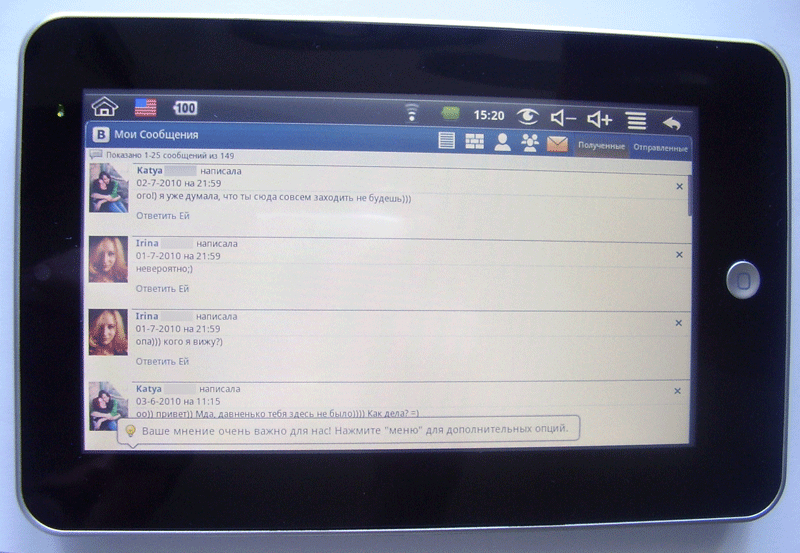
It's funny that with all this, the device considers itself a phone :)
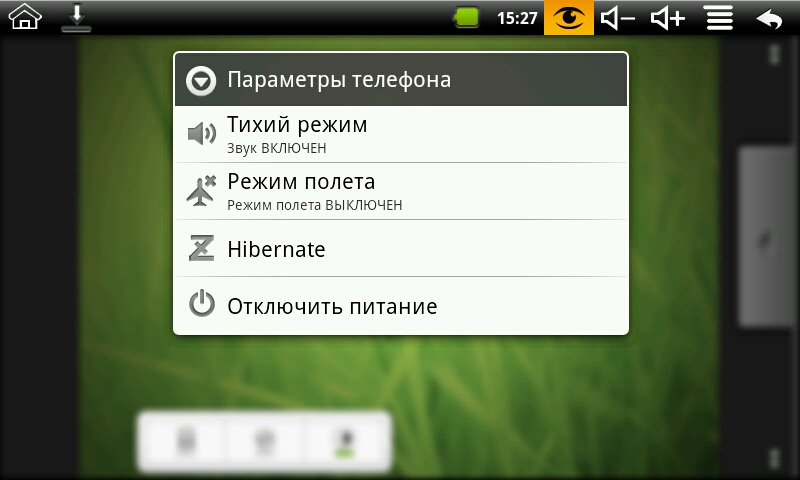
Regarding the operating time.
Batteries that thrifty Chinese put into their devices are a topic for another discussion. It seems that the battery capacity is chosen exclusively randomly, since the same devices at the same price can have completely different “batteries”.
I came across something with the declared 2400 mAh and, apparently, the way it is.
The device’s full charge time is 3 hours (the LED turns red at this time, and goes out at the end of charging), the operating time greatly depends on the brightness of the display and the Wi-Fi status.
My indicators are as follows:
in StandBy mode (the display is off, Wi-Fi is off, the system is working): up to 4 hours.
in StandBy mode (the display is off, Wi-Fi is on, the system is working): up to 3 hours.
in operating mode (maximum / average brightness, Wi-Fi off): up to 3 hours.
in operation mode (maximum / average brightness, Wi-Fi on): up to 2 hours.
in operating mode (minimum brightness, Wi-Fi off): more than 3 hours.
In the mode of "reading books" (minimum brightness, Wi-Fi is off, only FbReader is running), the device lasted 3 hours 20 minutes.
In order not to turn on / off the device, in order to save energy, there is Hibernate mode, which allows you to keep the system in a “ready” state but at the same time not to waste energy, as in StandBy.
A side effect of using the “overclocked” processor is that the device (especially when Wi-Fi is turned on) is quite noticeably heated.
The back surface reaches 40 degrees, and locally (apparently above the processor) - all 50.
Probably in wet weather this is more of a plus than a minus, but in the summer it causes some discomfort.
To summarize.
Advantages of the device:
[+] Low price
[+] Declared specifications correspond to real indicators
[+] Satisfactory build quality
[+] Fast operation of main applications (browser, office software, reader, audio player)
Disadvantages:
[-] Short time without recharging (average 2.5 - 3 hours)
[-] Not suitable for watching videos
[-] The device is warming up
[-] It is not possible to update the OS above version 1.6 (not supported by the processor)
In general: a nice and interesting toy for both geeks and lovers to sit on the Internet wherever he e st.
